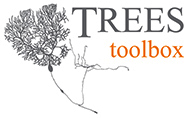
adapted from
PLoS supp. material
by Hermann Cuntz

![]()

The mtr_ panel is the most intricate panel and also the core panel
in the TREES toolbox GUI. Artificial trees can be constructed using
different methods such as automated reconstruction, cloning or fully manually.
The trees can be remodelled in many different ways including smoothing,
introducing jitter, resampling, diameter tapering,
addition of spines and somata or manual remodelling.
Equivalent trees can be obtained,
trees can be morphed or flattened or cut to pieces, etc..
The edit modes in this panel have multiple sub-modes allowing the editing of single nodes,
selected nodes, sub-trees etc...
In the automated reconstruction process the first step is to connect
the skeletonized points obtained by the skl_ panel to a graph.
This is done in the TREES toolbox using the MST constructor
(see „MST rule“ in the introductary part)
following a greedy algorithm to obtain an extended minimum spanning tree.
The constructor is launched with the „MST“ button in the mtr_ panel.

Because of the central role of the mtr_ panel a number
of different representations exist. By default (first radio button),
a tree is represented as rectangular pieces between two connected nodes
corresponding to the cylinder or frustum.
The rectangular pieces are mapped to the active vis_ plane,
in this case in the XY-plane.
A green circle indicates the last activated node (here the root).

Additionally, the second radio button allows a 3D visualization of the tree.
The last radio button toggles transparency.
In order to set higher or lower cylinder resolution go to the “Visualize” menu.

As an alternative to the second option a graph representing
the edges between nodes as arrows can be selected using the third radio buttion.

If an Nx1 vector has been selected with the slt_ panel (see later),
this can be mapped on the colour values of the tree again as an alternative
to the second option. This happens when toggling ON the fourth radio button.

The resulting tree from the reconstruction process is ready for manual editing
(see later) but can also simply be cleaned up with different cleaning algorithms.

Clean a tree
Cleaning a tree
(see “clean_tree”)
is a process in which improbable nodes are eliminated.
Termination points in close vicinity of other nodes on a different branch
and very short terminal branches are deleted.
Consecutive calls of this function can be useful.

Resample a tree
Resampling a tree
(see “resample_tree”)
redistributes nodes such that segments are constant length.
This is required to get a unique graph representation,
and to apply functions such as adding a spatial jitter
or a number of spines homogeneously.

Smoothing a tree
Smoothing a tree
(see “smooth_tree”) along its longest paths.

Add spatial jitter
If additional jitter is desired it can be applied here
(see “jitter_tree”).

Fit quadratic taper
(see “quadfit_tree”)
Fitting scaling and offset parameters for the quadratic taper.
In this case it results in an almost constant diameter throughout.

Quadratic taper
(see “quaddiameter_tree”)
Scaling and offset parameters can also be set by hand.

Add spines
(see “spines_tree”)
Distributes a number of spines either attached to nodes randomly
(among selection if exists) or on skl_ panel carrier point locations.

Add soma
(see “soma_tree”)
Increases diameter in the vicinity of the root of the tree.

mtr_ edit mode
When the edit mode is turned on and the mtr_ panel is active,
the active tree is drawn in thick red lines.
The red dashed edit line indicates which node is closest.
With simple mouse clicks and holding, new branches can be drawn.

mtr_ edit submodes for altering the node locations
In the mtr_ edit mode clicking near an existing node
(edit line becomes green) allows the user to move the node around
with the active plane. Different submodes allow the movement of a single node (single),
all selected nodes (sel.),
an entire sub-tree (subtree)
or nodes in the close vicinity where the amount of displacement depends
on the distance to the originally selected node (goo)

mtr_ edit-select mode
When the edit mode is turned on and the mtr_ panel is active,
the active tree is draw in thick red lines.
The red dashed edit line indicates which node is closest.
With simple mouse clicks and holding, new branches can be drawn.
As can be seen here clearly and in the previous example the green circle
demarcating the last activated node moves while clicking on the tree for editing.

redirect and repair
Finally, the root can be moved to another location by redirecting
the underlying graph of the tree
(see “redirect_tree”)
and the adjacency matrix can be sorted
(see “repair_tree”)
in order to correctly perform operations such as the dendrogram plotting
and to obtain a unique representation of the tree.

notes on redirect
When a tree is redirected,
its root is newly set to the last activated node shown by the green circle.
Note that the root diameter is never visible but becomes concrete on moving the root
in the cylinder representation (use frustum representation to avoid this).
equivalent tree
(see “BCT_tree”)
Attributes a set of new unique metrics to a tree according
to a dendrogram-type of organization.
Electrotonically this tree is equivalent to the original.

disconnect a sub-tree
Unconnect a sub-tree from the main tree at the last activated node
(green circle, is set in the edit mode).
The ged_ and cat_ panels allow rearrangement of the resulting trees
and a possible reconnection.
correct tree in z
(see “zcorr_tree”)
Sometimes trees might contain unexpected jumps in the z-dimension,
this can be corrected here.
morphing
(see “morph_tree”)
Attribute Nx1 vector values to the lengths of the indidual segments
selected by the slt_ panel (see later).
Here for example diameter values are mapped to the length
(doesn’t make much sense...).



This work is licensed under a
Creative Commons Attribution-Noncommercial-Share Alike 3.0 License